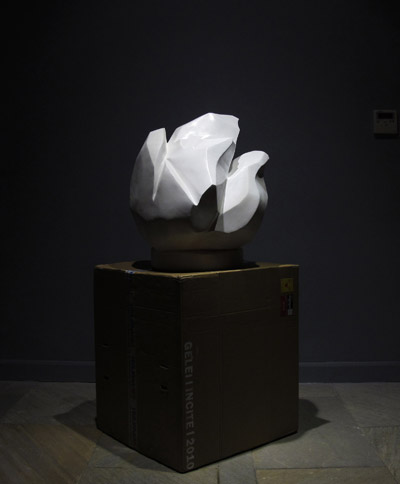CONCEPTION AS ENZYME
| December 1, 2010 | Post In LEAP 6

“Conception As Enzyme” is consistent with curator Bao Dong’s overall curatorial and critical direction. A creative experiment based on the notion of “conception,” the exhibition resorts to an in-depth discursive and representative exploration that opens out into a profound inspection and review of present reality. The venue’s set-up is a visual labyrinth that consumes the viewer’s senses of sight, touch, and hearing; every single bodily reserve is fully mobilized. Implicit in this rich sensory experience is an intense awareness and self-consciousness: here, in a sense, art is not art; it is inherently thought.
Artist Jin Feng has reproduced—in neon lights—the original contents of a letter written by American President Barack Obama, from June of this year, in reply to Chengdu citizen Li Liang; only certain characters are illuminated, spelling out the sentence, “I thank you for your petition to the White House.” Formally speaking, the piece may appear indistinct from what one might classify as Western “conceptual art,” but when we enter into its internal discourse, we do not find a mere restatement of social events, nor do we discover a readily simplified political position; rather, we come upon rich cultural and political implication, released through the crystallization of a concept. Likewise, on the surface, Jiang Peng’s Cross Word appears a kind of idea or word game, but amidst the English words it spells out—“cross-over, derive, split apart, re-generate”—lurks a profound understanding, consideration, and satirization of the boundaries of contemporary art; it is presented as a system, but in reality it is a vortex. Then there is Shi Qing, who frankly acknowledges that even he does not understand his work. Yet in spite of, or perhaps because of this, the dimensions of meaning are numerous and deep-reaching. In Symmetric Drift, four freely moving symmetrical cubes serve as a visuospatial metaphor for the modern nomad’s rovings about the geographical landscape. Though the work appears to occur organically, it is dictated by its own rationale; whether in terms of its material or visual components, it is abundant with difference and uncertainty. Also a particularly remarkable choice, Yu Ji’s work Key Words and Key Drawing is semantically based on all of the other participating works in the exhibition. Taking control of the formation each of their ideas, Yu Ji deconstructs and then reconstructs them, in a kind of “conception of conception.” “Form” is not important here; what is important, again, is the conception behind it: in this case, profound ridicule and reflection.
It is my belief that any attempt to find a thread of logic woven through this collection of works is doomed to fail; it is an exhibition fundamentally without logic. Indeed, perhaps the important thing is not conception itself, but rather “a notion of conception that is more like an ‘enzyme,’” with all the openness to change and derivation thus implied. The idea of enzymatic shape shifting certainly carries significance as far as today’s contemporary art world and its politico-cultural environment are concerned. But the problem is, when the possibilities are limitless—when conception is infinitely generalized—what then of meaning? Even more importantly, when consciousness is transformed solely into the possibility of altering (or recognizing) the possibilities of our reality, what is the difference between so-called “art as consciousness” and traditional “conceptual art”? Would the difference lie somewhere between the status of the latter as a mere “point” and the status of the former as a slightly more complex, slightly more interesting series of “points”? Perhaps Susan Sontag said it best: “Art is not consciousness per se, but rather its antidote—evolved from within consciousness itself.” Still, during the exhibition symposium, Bao Dong informed us that “consciousness” here is not the same as Sontag’s. In other words, he cares mainly about the intellectual and introspective urge of the subject. Lu Mingjun

